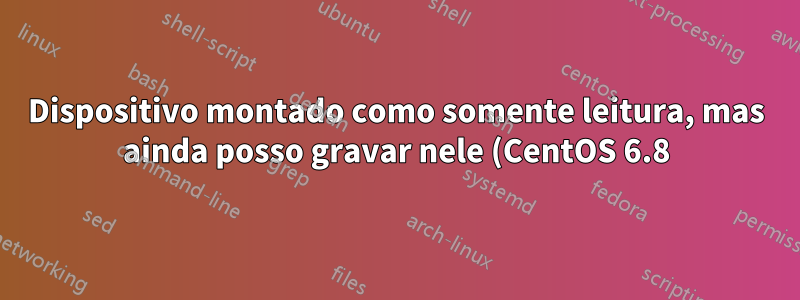.png)
Tenho o CentOS 6.8 instalado em uma unidade flash e devido ao seu ciclo de vida limitado (100.000 gravações (tempo médio antes da falha para cada setor)), quero montá-lo como somente leitura.
O kernel está supostamente sendo lançado como ro. Pelo menos, o resultado cat /proc/cmdlinecomeça com "ro ...".
Eu configurei /etc/fstabpara montar somente leitura:
UUID=4addd4a7-97f6-4399-89e4-6d3728bd2979 / ext4 defaults,noatime,ro 1 1
UUID=21a81149-6534-4313-8696-e203896d5881 /boot ext4 defaults,noatime,ro 1 2
UUID=D64B-DD9C /boot/efi vfat noatime,ro,umask=0077,shortname=winnt 0 0
tmpfs /dev/shm tmpfs defaults 0 0
devpts /dev/pts devpts gid=5,mode=620 0 0
sysfs /sys sysfs defaults 0 0
proc /proc proc defaults 0 0
tmpfs /var/log tmpfs defaults 0 0
Quando executo mount, vejo que as especificações /etc/fstabforam seguidas. Apesar disso, ainda posso modificar arquivos e gravar novos arquivos. Mais evidências de que a montagem pode ser escrita está em execução lsof(de acordo comesta postagem). Os resultados mostram alguns arquivos abertos para gravação, principalmente em/home. (Para chegar a isso, tive que montar /var/logcomo tmpfs.)
Isso é um bug no CentOS 6.8? Existe uma solução alternativa?
Responder1
Lembro-me de ter lido em algum lugar, provavelmente nas páginas de manual, que existe um tipo de bug que significa que para fazer um dispositivo somente leitura você também precisa remontar o dispositivo.
mount -o remount,ro ...
tente adicionar uma remontagem após as outras entradas no fstab, ps mount pode receber o sistema de arquivos "none" no fstab.
ATUALIZAR:
Encontrei a entrada man relevante;
mount(8) since v2.27 allows to change the mount options by passing the relevant options along with --bind. For example:
mount --bind,ro foo foo
This feature is not supported by the Linux kernel; it is implemented in userspace by an additional mount(2) remounting syscall. This solution is not atomic.
The alternative (classic) way to create a read-only bind mount is to use the remount operation, for example:
mount --bind olddir newdir
mount -o remount,ro,bind olddir newdir
Note that a read-only bind will create a read-only mountpoint (VFS entry), but the original filesystem superblock will still be writable, meaning that the olddir will be
writable, but the newdir will be read-only.
It's impossible to change mount options recursively (for example with -o rbind,ro).
com base nisso, você pode tentar usar as opções do fstab;
default,rbind,ro
caso contrário, adicione uma entrada para remontar.
ATUALIZAÇÃO 2 (man 8 mount / man 8 mount blockdev);
-r, --read-only
Mount the filesystem read-only. A synonym is -o ro.
Note that, depending on the filesystem type, state and kernel behavior, the system may still write to the device. For example, ext3 and ext4 will replay the journal if
the filesystem is dirty. To prevent this kind of write access, you may want to mount an ext3 or ext4 filesystem with the ro,noload mount options or set the block device
itself to read-only mode, see the blockdev(8) command.
Isso significa que você tem a opção de;
ro,noload
ou para usar;
blockdev --setro /dev/...


